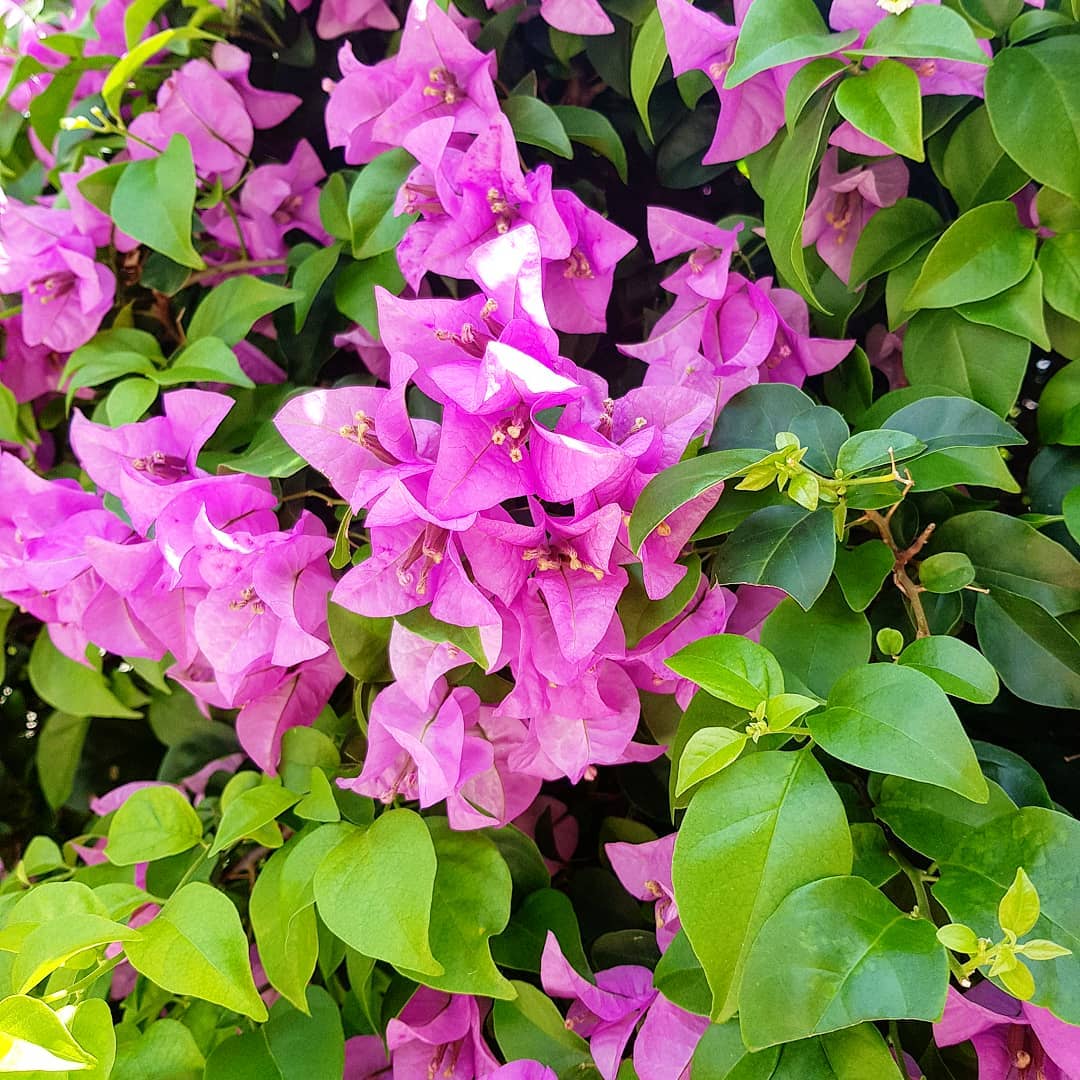Bougainvillea relatively recently started to gain popularity among gardeners, was given the nickname "paper flower" due to its characteristic of bright bracts. In nature this plant is found in Brazil, forming a creeping shrub with branches, lianas to 5 m, occasionally a tree. The stems are fairly large spikes, which in their natural habitat of bougainvilleas often clings to rocks or other supports. The leaves are oval, with pointed tips and smooth edge; underside lighter than upper. The flowers are small, yellow, surrounded by colorful bracts (bracteate), often crimson or purple. It blooms from may to October and in vivo up to 9 months.
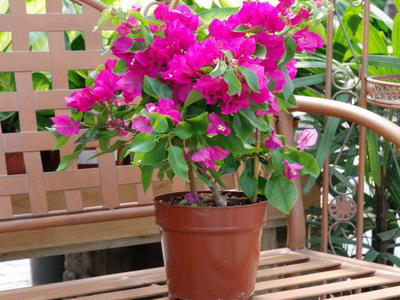
Used as a houseplant, as well as on the street: she's beautiful braids of the South wall and railings, arches, patios, balconies. It is possible to form a Bush of any shape, shoots twisting around supports or a tree. Often planted 3 bougainvillea in different colors in one tub, braid their trunks loose "pigtail" around the support, and the top form a crown – as a rule, spherical. In the flowering period this tri-colored plant looks fatastically.
Species and varieties
In nature, there are about 15 species of bougainvillea, but in the culture grown only 3: Bougainvillea Smooth (the dwarf and compact, convenient for apartments), and a Wonderful Bougainvillea Bougainvillea Buttiana (the best option for cutting and shaping).
Artificially bred hybrids differ mainly in color, size and shape of the bracts. For example, Vera Deep Purple has large pinkish-crimson bracts, Donyo – pale pink, Jamaica White – large white, Singapore Pink – lilac, long, Glabra lilac-purple.
Some varieties change the color of the bracts during flowering: Bois de Roses (early flowering bright orange, with pink, large bracts), California Gold (bright yellow, lighter), Mrs Butt Compact(color red brick turns into crimson).
There are also variegated varieties: Harris (with cream streaks on the leaves) and Sanderana white (with beige trim).
Terry varieties have a lot of bright bracts of different sizes, tightly gathered around each flower (from simple varieties only 3 bracts each flower). These include Double Red (Fuxiao crimson) and Thai Gold (bright orange at the beginning of flowering to conzco becomes pale pink).
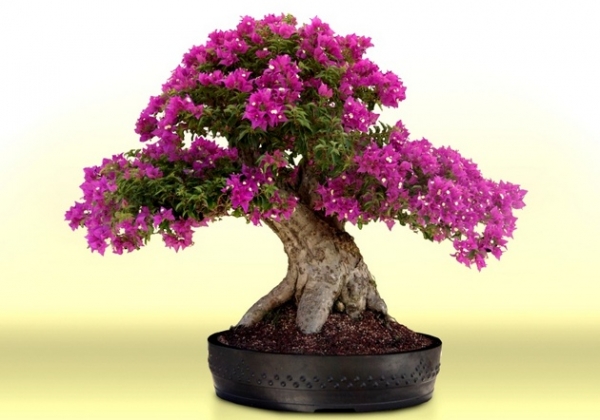
The cultivation and care
Growing bougainvillea – it's not too time consuming, and fully pays off its bright and very long flowering. But be careful – improper care of this flower may stop blooming and drop all the leaves. However, he quickly restored in all its glory as soon as you fix the conditions of his life.
- Lighting should be bright, abundant from spring to the end of the summer – not less than 5 hours a day of direct sunlight. This is, perhaps, the main condition for the normal development of bougainvillea.
In the warm season is useful to make copies of room on the balcony or in the yard. But don't forget to gradually accustom them to the sunlight.
In winter, if not reduce temperatures up to +100C, arrange the extra coverage.
In low light shoots elongated, leaves are growing rarer and smaller, and flowering is reduced or terminated.
- The temperature of the air from March to beginning of November should be between +22 — +300C, but in winter it is desirable to provide a period of rest at +7 — +120C. Dropping leaves when the winter is normal, the spring will be new, along with the buds.
If it is not possible to lower the temperature of the bougainvillea will survive, maybe even bloom in winter, but winter and the subsequent spring bloom is very scarce.
Do not overdo it with cold winter – at temperatures below +10 C the plant will die from hypothermia root system.
- Watering needs regular and abundant between watering the soil should dry out for 2 – 3cm.
Water for irrigation is warm, + 20 to +250C, no chlorine (water defend 1 day)
During the cold winter watering minimize up to 2 – 3 times a month
- Spray spray the bougainvillea out back next to the summer drought, but can be all year if the temperature is above +150C. Do it in the morning, clean with water at room temperature.
- Feeding is carried out every 2 weeks from March to September, alternating potassium and phosphorus fertilizers with organic (e.g., slurry).
- Soil use a standard composed of equal parts of turf earth, humus, peat and sand. Peat can be replaced by double portion of ground sheet. You can also buy a special substrate for bougainvillea in the store. At the bottom of the pot required drainage.
- The transplant is held in the spring, young plants need it every 2 years, and adults – every 3 to 5 years. Signal the day of the transplantation are roots, which are beginning to be seen in the drainage holes, or soil depletion.
Bougainvillea roots are very delicate, thin, so earthen is better not to disturb.
The pot should be deep enough for 2 – 3cm larger in diameter than the previous one. In too large a pot at bougainvillea will quickly grow large branches, but will decrease flowering.
And don't forget to provide support to the stem.
The first days after transplanting the flower out of direct sunlight and don't water – it stimulates rooting.
- Bougainvillea growing on the street, in winter you need to cover. The least cold-resistant varieties and hybrids white perianth.
- Large and outdoor plants are cut. Basic hairstyle is in autumn, immediately after flowering all of last year's shoots shortened by ½ the length – it stimulates the growth of side shoots.
If wither of the main branches to trim the ends on the lateral shoots will begin to form buds.
In late February form the plants send shoots into the shape. Then delete the old curves and branches (side shoots and leaving the main 1 sheet and 1 sheet of the kidney).
When cutting remember that in lignified shoots (2 – 3 years) no flowers or side shoots do not appear.
- Almost all varieties of bougainvilleas need the space, so send them around the support not too tight and do not put side by side with other plants – this will limit lighting for both.
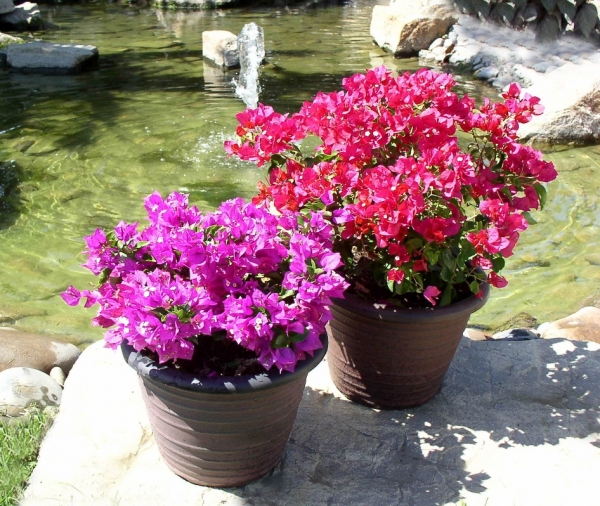
Reproduction
Indoor bougainvillea is propagated usually by cuttings, and shrub – cuttings. Seed propagation is rarely used, because the seeds in the stores do not meet — only available for ordering via the Internet. This is due to the fact that pollination necessarily need either a Hummingbird or butterfly hyles.
Cuttings use spring, which remained after cutting or cut especially in the summer. Each stalk should be at least 1 kidney, lengths up to 10cm. Cut it just below the Bud, the lower leaves are removed, the cut is treated with the stimulator of root formation, or simply dusted with coal. If the branch was over 1 year and started to odrevesnevshie, soak it in warm water for 3 hours. Planted them in a mixture of peat with sand (or sphagnum moss with sand and coal) at an angle of about 450, buried 2 internodes. Landing put on a top glass cover or construct a mini-greenhouse of transparent film, provide a temperature of +23 – +300C and good lighting without direct sunlight. Further care is daily airing and spraying of seedlings and the removal of condensate.
Cuttings can be rooted at any time of the year, except late autumn and winter. With the plant of the plant bougainvillea choose semilignified escape, make the notch or remove 2 – 3 ring of bark at a height of approximately 1/3 of the length of the branches. This thread bend over and prishpilivayut to the ground, filling the damaged part of the nutrient soil or peat. Be separated and planted in a permanent place a new plant next year.
Seeds, as mentioned above, it is difficult to buy, bougainvillea of them are growing pretty slowly (for six months from the time of sowing up to 15cm). If you managed to get the seeds, soak them before planting in a solution of growth stimulator for 3 to 4 hours, and then visate surface in a mixture of peat or leaf soil with sand. It is desirable to allocate to each separate seed Cup, so you do not damage the delicate roots when transplanting. The conditions of germination – maximum humidity (cover film or glass); good lighting in the winter – fluorescent lamp is approximately 25cm above the soil; the temperature is +26 — +280S, and preferably the bottom heat. Germination can be expected within 2 – 4 months.
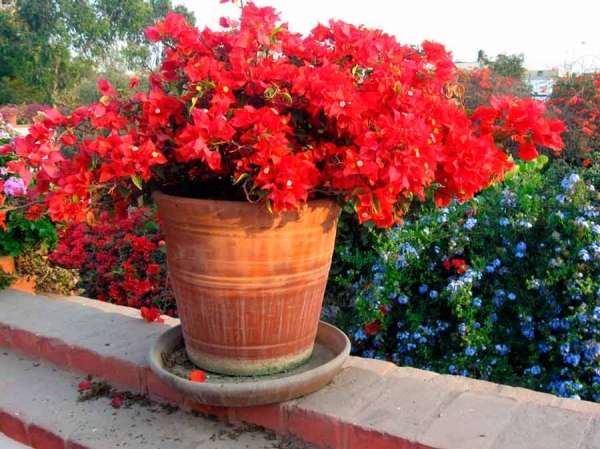
Pests and potential complexity of care
Outdoors bougainvillea is not subject to any diseases or pests, but the room is subject to attacks of aphids, mealybugs, and occasionally spider mites.
To prevent pests regularly clean dust off foliage, remove dead leaves and blossoms and inspect the stems and leaves every 4 to 5 days during the flowering period.
If on lower side of leaves was discovered aphid, which feeds on the juice of the plant, treat the flower solution aktellika.
If the leaves become sticky, then infested with mealybug. These sticky sheets often settles sooty fungus, repainting them black. If this happens with your bougainvillea, remove any black leaves, and the rest clean with a solution of insecticide or soap.
Resets the leaves of bougainvillea or for the period of a cold winter or when excess moisture. In any case, drastically reduce watering.
No blooms this plant from lack of fresh air or excess moisture. To stimulate flowering will help stress: place a bougainvillea in the balcony or outside (if warm), dramatically reduce watering and stop feeding. Resume all as soon as you notice the buds.
Vegetables and Barley Soup preparation for the winter
How should be dried removed onions and garlic
Dutch cabbage: planting, care, types
